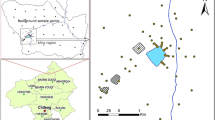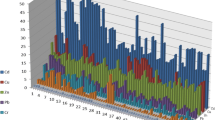Abstract
In this study, soil samples were collected from the zinc sand smelter site within the depth range of 0–1.5 m. The contents of As, Cd, Cu, Pb, Ni, Zn, Hg and Cr were determined, the spatial distribution characteristics and sources of heavy metals were analyzed, and the heavy metal pollution was evaluated by the Nemero integrated pollution index method and the ecological risk index method. The results showed that the contents of Cr, Cu, Ni, Zn and Hg were within the screening values for industrial sites of EPA’s General Soil Screening Values, and the exceedance rates of As, Cd and Pb were 100.00% and 9.52%, respectively. The surface heavy metals were mainly distributed in the pickling and purification system area, sedimentation pond, sewage treatment station, feed storage and sulfuric acid storage tank area. In the vertical direction, heavy metals show surface aggregation, but there is also obvious vertical migration, Cd content increases with depth, Cu and Pb content decreases with depth, As, Ni, Zn and Hg content is relatively uniform. The maximum values of As and Pb in the sewage treatment station, pickling purification system area and sedimentation pond were exceeded, and the exceedance multiples were 110.81 times and 2.65 times, respectively. The pollution degree and potential ecological risk of soil in different functional areas are in the following order: pickling purification system area > sewage treatment pond > sulfuric acid storage tank area > sedimentation pond area > boiling furnace roasting system area > clearing bag pond area > feed storage area > office area > drying system area > conversion absorption system area > warehouse area. Except for the acid washing and purification system area, which has medium potential ecological risk, all other functional areas have slight potential ecological risk. The main sources of Cd, Cu, Pb, Zn and Hg in the site soil are acid-containing wastewater from acid production process, rinsing wastewater and precipitated metal sludge and precipitated calcium sulfate sludge from wastewater dosing treatment; the main sources of arsenic are acid-containing wastewater and rinsing wastewater from acid production process; nickel may be a mixed source of natural geological background and human production activities.



Similar content being viewed by others
Availability of data and materials
Data sharing not applicable to this article as no data sets were generated or analyzed during the current study.
References
Arslan Topal EI, Topal M, Öbek E (2022) Assessment of heavy metal accumulations and health risk potentials in tomatoes grown in the discharge area of a municipal wastewater treatment plant. Int J Environ Health Res 32(2):393–405
Bu X-B, Feng Q, Liao C, Feng Y-C, Liu J-Q, Wang H-Z (2022) Study on heavy mental pollution in highway soil based on principal component analysis. J Saf Environ 22(4):2241–2247. https://doi.org/10.13637/j.issn.1009-6094.2021.1673
Chen H-Y (2022) Study on the impact of the integrity of environmental protection archives of enterprises involving heavy metals on the investigation of soil pollution. Lantai World (04):52–54. https://doi.org/10.16565/j.cnki.1006-7744.2022.04.14
Cheng J-W, Cai S-W, Huang M-Q, Yan X (2022) Heavy metal speciation migration transformation and risk assessment in plant rhizosphere soil of Zunyi manganese mineland. Guizhou Environ Chem 41(09):2833–2841
Dai P-F, Huang D-J, Wang S, Dai Y, Qian K, Zheng H (2021) Determination and comprehensive evaluation of heavy metal pollution of farmland soil in a uranium mining area. Chin J Soil Sci 52(1):198–202. https://doi.org/10.19336/j.cnki.trtb.2020041401
Feng D-B, Dong S-Y, Yang L, Guo W-B, Chen Q (2022) Characteristics and evaluation of soil heavy mental pollution in Lechang lead–zinc mine, Shaoguan City. Guangdong Province. Mineral Petrol 42(3):123–133. https://doi.org/10.19719/j.cnki.1001-6872.2022.03.12
Gao L, Li R, Liang Z, Wu Q, Yang Z, Li M, Chen J, Hou L (2021) Mobilization mechanisms and toxicity risk of sediment trace metals (Cu, Zn, Ni, and Pb) based on diffusive gradients in thin films: a case study in the Xizhi River basin, South China. J Hazard Mater 410:124590
Guo G, Li K, Lei M (2022) Accumulation, environmental risk characteristics and associated driving mechanisms of potential toxicity elements in roadside soils across China. Sci Total Environ 835:155342
Huang J-B, Jiang D-D, Wen B, Wang L, Shi J-Q, Zhou Y (2022) Contamination and probabilistic health risk assessment of heavy mental in agricultural soils around lead–zinc smelter. Environ Sci. https://doi.org/10.13227/j.hjkx.202205055
Li Y-H (2018) Study on spatial distribution and treatment of industrial pollution in China. Economist (9):59–65. https://doi.org/10.16158/j.cnki.51-1312/f.2018.09.007
Li T, Li Z-Y, Liu H, Li Y-G, Li S-M, Ouyang Y, Zhang T-G, Zhang J-H, Huang Y (2022) Migration and enrichment characteristics of heavy metals in purple soil of a profile in the Pushi clastic rock area, Xichang region, Sichuan, China and their ecological risk assessment. Acta Mineral Sin 43(1):125–136. https://doi.org/10.16461/j.cnki.1000-4734.2022.42.079
Lu X-H, Yu F-Z, Fan Y-M, Yang Y (2022a) Spatial distribution characteristics and source analysis of heavy metals in soil of a lead plant in Sanmenxia. Environ Sci. https://doi.org/10.13227/j.hjkx.202205052
Lu Y-F, Lu Y, Cai H, Sun S-J, Shi W-L (2022b) Pollution analysis and health risk assessment of heavy metals in field left by a lead-acid battery factory. Environ Eng 40(1):135–140189. https://doi.org/10.13205/j.hjgc.202201020
Peng C, Liu X, Zhou Z-R, Jiang Z-C, Guo Z-H, Xiao X-Y (2022) Characteristics and risk assessment of heavy metals in the soil around copper smelting sites. Environ Sci 44(1):367–375. https://doi.org/10.13227/j.hjkx.202201040
Shao F-S, Zhou H-Y (1998) Soil environmental background values of main elements in Henan province. Agric Henan (10):28
Shao H-Q, Zhang Y-W, Qu C, Li W-H, Zhao Y-J, Liu N, Cai H-M, Wu C-D, Liu JM (2020) Analysis of heavy metal contamination in the soil and enrichment capabilities of terrestrial plants around a typical vanadium smelter area. Chin J Eng 42(3):302–312. https://doi.org/10.13374/j.issn2095-9389.2019.04.23.001
Sun H-Y, Wei X-F, Sun X-M, Jia F-C, Li D-J, Li J (2021) Bioaccumulation and translocation characteristics of heavy metals in a soil-maize system in reclaimed land and surrounding areas of typical vanadium-titanium magnetite tailings. Environ Sci 42(3):1166–1176. https://doi.org/10.13227/j.hjkx.202007200
Tang S-Q, Liu X-J, Yang K, Guo F, Yang Z, Ma H-H, Liu F, Peng M, Li K (2021) Migration, transformation characteristics, and ecological risk evaluation of heavy metal fractions in cultivated soil profiles in a typical carbonate-covered area. Environ Sci 42(8):3913–3923. https://doi.org/10.13227/J.HJKX.202101066
Tepanosyan G, Harutyunyan N, Maghakyan N, Sahakyan L (2022) Potentially toxic elements contents and the associated potential ecological risk in the bottom sediments of Hrazdan river under the impact of Yerevan city (Armenia). Environ Sci Pollut Res 29(24):36985–37003
Topal M, Arslan Topal EI (2020) Phytoremediaton of priority substances (Pb and Ni) by Phragmites australis exposed to poultry slaughterhouse wastewater. Int J Phytoremediation 22(8):857–862
Topal M, Arslan Topal EI, Öbek E (2020) Investigation of potential health risks in terms of arsenic in grapevine exposed to gallery waters of an abandoned mining area in Turkey. Environ Technol Innov 20:101058
Tu D-G, Feng T, Yang G-D, Luo W-W, Nie B-L (2022) Pollution analysis and health risk assessment of heavy metals in an abandoned machinery plant. Environ Eng 40(4):217–223. https://doi.org/10.13205/j.hjgc.202204031
Wang Y-J, Zhou D-M, Sun R-J, Hao X-Z, Cang L (2006) Competitive adsorption kinetics of copper and lead ions in soils. China Environ Sci 26(5):555–559. https://doi.org/10.3321/j.issn:1000-6923.2006.05.011
Wang S-T, Gong L-K, Ren R, Jin Q (2020) Determination of heavy metal and rare earth elements in Mose bamboo shoot by microwave digestion-ICP-MS/MS. Chin J Health Lab Technol 30(14):1679–1685
Wang X-F, Lan W-B, Xiao Q-P, Meng Y-B, Qiu B, Li Z-Y, He L-P (2022a) Evaluation of soil environmental quality of cultivated land in the Donghe River Basin of Chenzhou City, Hunan Province by three methods. J Environ Occup Med 39(6):684–689
Wang Y, Mo L, Yu X-X, Shi H-D, Fei Y (2022b) Enrichment characteristics, source apportionment, and risk assessment of heavy metals in the industrial and mining area of Northern Guangdong Province. Environ Sci. https://doi.org/10.13227/j.hjkx.202204271
Wu A-L, Luo S-Q, Zhao Y-N, Zhao J, Lian X-M (2021) Survey and evaluation of heavy metal pollution of food in Chongqing by contamination index method. Chin J Food Hyg 33(2):175–180. https://doi.org/10.13590/j.cjfh.2021.02.010
Xiang L-J, Su Q, Sun G, Zhang Y, Ding J-Q, Wang Q, Yu J (2022) Characteristics and causes of soil heavy metal pollution in typical pharmaceutical enterprise gathering areas. Environ Chem 41(6):2022–2034
Xiong J, Han Z-W, Wu P, Zeng X-Y, Luo G-F, Yang W-T (2020) Spatial distribution characteristics, contamination evaluation and health risk assessment of arsenic and antimony in soil around an antimony smelter of Dushan County. Acta Sci Circum 40(2):655–664. https://doi.org/10.13671/j.hjkxxb.2019.0387
Yao D-J, Liu E-G, Ning Z-P, Xiao T-F, Ma L, Zeng G-N, Liu Y-Z, Hu F, Liu C-S (2021) Contamination and human health risks of Sb and As in farmland soils around a typical antimony smelter in Guizhou, China. Earth Environ 49(6):673–683. https://doi.org/10.14050/j.cnki.1672-9250.2021.49.058
Zhao X-M, Dong D-M, Chen Y, Hua X-Y (2008) Effects of chemical environment in solution on the adsorption and vertical transport of Cr(VI) and As(V) in farmland soil. J Agro-Environ Sci 27(6):2233–2239. https://doi.org/10.3321/j.issn:1672-2043.2008.06.019
Zheng Y-Y, Liu J, Jiang P-P, You S-H, Zhou S-L, Yu G (2021) Pollution analysis and health risk assessment of heavy metals in farmland soils around an abandoned smelter in Hechi, China. Environ Eng 39(5):238–245. https://doi.org/10.13205/j.hjgc.202105033
Zhou Z-F, Liu K, Zeng H-X (2021) Multi-evolutionary game study on soil heavy metal pollution treatment. Ecol Econ 37(4):183–193
Zhu L-J, Zhang J-C, Jiang J, Yu Y-C, Zai D-X (2008) Adsorption and competitive adsorption of copper and other metal ion by bentonite. Environ Sci Manage 33(12):26–29
Acknowledgements
This work was supported by the National Natural Science Foundation of China (41201224); Henan Province Science and Technology Research Project (192102110050); Project for the Training of Young Backbone Teachers of Higher Education Institutions in Henan Province (2018GGJS047).
Funding
This study was funded by the National Natural Science Foundation of China (41201224).
Author information
Authors and Affiliations
Contributions
All authors contributed to the study conception and design. Material preparation, data collection and analysis were performed by SY. The first draft of the manuscript was written by DY and all authors commented on previous versions of the manuscript. All authors read and approved the final manuscript.
Corresponding author
Ethics declarations
Conflict of interest
All authors certify that they have no affiliations with or involvement in any organization or entity with any financial interest or non-financial interest in the subject matter or materials discussed in this manuscript.
Ethics approval and consent to participate
All authors declare that there is no ethical violation in this manuscript. In addition, this manuscript does not contain date belonging to others.
Additional information
Publisher's Note
Springer Nature remains neutral with regard to jurisdictional claims in published maps and institutional affiliations.
Rights and permissions
Springer Nature or its licensor (e.g. a society or other partner) holds exclusive rights to this article under a publishing agreement with the author(s) or other rightsholder(s); author self-archiving of the accepted manuscript version of this article is solely governed by the terms of such publishing agreement and applicable law.
About this article
Cite this article
Yang, S., Hui, W., Jiangtao, J. et al. Characteristics of heavy metal contamination in the soil of a legacy site of a zinc sand smelter evaluation. Environ Earth Sci 82, 521 (2023). https://doi.org/10.1007/s12665-023-11131-7
Received:
Accepted:
Published:
DOI: https://doi.org/10.1007/s12665-023-11131-7




